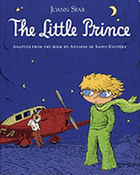
For those of us who revere The Little Prince as a book we return to again and again, the idea of a graphic novel interpretation may fill us with trepidation. Will it live up to the spirit of that wise and penetrating original text? Will a multitude of illustrations detract from our memory of the spare ink-and-watercolor renderings of the wheat-haired hero that punctuate the pilot's narrative? For this Little Prince fan, this graphic novel edition deepens the experience of Saint-Exupéry's narrative. Joann Sfar's panel illustrations--six to a page, 12 per spread--ask us to revisit the fox, to "go and see the roses again" and to remember what the fox told the Little Prince about the rose he tamed on his planet, asteroid B-612: "You can only see clearly with the heart. What matters is invisible to the eye."
Some of us may be wedded to the original 1943 English translation of Saint-Exupéry's phrasings ("It is only with the heart that one can see rightly; what is essential is invisible to the eye"). But Sfar's illustrations, together with Ardizzone's translation, reimagine the book distilled to those "essential" qualities. Sfar places the pilot, in the likeness of Saint-Exupéry himself (shown on the dust jacket flap in a photo), into the visual narrative, and literally and brilliantly unwinds the story of friendship--between a prince and his rose, and a prince and the fox he tames--within a sequence that chronicles the growing trust between the boy prince and the storyteller.
They meet in a six-panel scene in which the boy wakes the pilot, asleep beside his plane that has crash-landed in the Sahara Desert, and the Little Prince asks him: "Please. Draw me a sheep." The man shows the boy his drawing, made at age six, which grown-ups have always misidentified as a hat ("This is the only thing I know how to draw"), and the boy immediately recognizes it as a picture of "an elephant inside a boa constrictor." Now the pilot wants to please the boy by attempting to fulfill his request, and a fragile bond forms. (Sfar pays tribute to Saint-Exupéry's artwork by re-creating near-replicas of both the boa--aka "Drawing Number One" in the original book--and the subsequent drawing of the sheep inside a box, in a spiral notebook that the pilot carries.) Later, when the pilot, intent on fixing his airplane, tries to brush off the Little Prince's questions, the boy brings the man back to himself by reminding him of what truly matters. He tells the pilot the story of his rose.
Here Findakly works her magic: as the Little Prince tells of his rose (which Sfar portrays as a sensuous, nymph-like creature in the center of a petal stage), she keeps the palette consistent with the night-sky backdrop for the pilot and the boy prince's first meeting. At the moment when the Little Prince leaves his rose, the scene shifts to a fiery red. The hero's subsequent intergalactic adventures (involving the king with no subjects, the businessman who counts the stars, the relentless lamplighter) also play out against an array of saturated, slightly surreal shades of aquamarine, violet and gold. But once the boy reaches Earth and meets the fateful snake (who will ultimately "transport" him home), the scene returns again to the night-sky palette. In the climactic scene in which the Little Prince meets the fox, the color of the sky echoes the boy's eyes, and the fox's eyes match the color of the sun, the flowers in the field and the Little Prince's hair.
Because of Sfar's choice to include the pilot in his images, the conclusion of the book resonates profoundly. Saint-Exupéry ends with the image of the Little Prince looking up at his star, his wheat-colored hair blown in such a way that it mirrors the shape of the star, and on the next page, the identical scene but absent of the boy: "the loveliest and saddest landscape in the world...." Sfar's ending takes us back to that first six-panel sequence when the Little Prince wakens the pilot--except without the speech balloons. Next, he presents the same sequence again--but without the Little Prince, and the words, "For me, this is the most beautiful and the saddest landscape in the world...." In the third and final repetition of the six-panel sequence, there are no words and no pilot. Only the plane remains. Were the Little Prince and the pilot ever really there? Sfar seems to wordlessly say, "What matters is invisible to the eye."--Jennifer M. Brown

